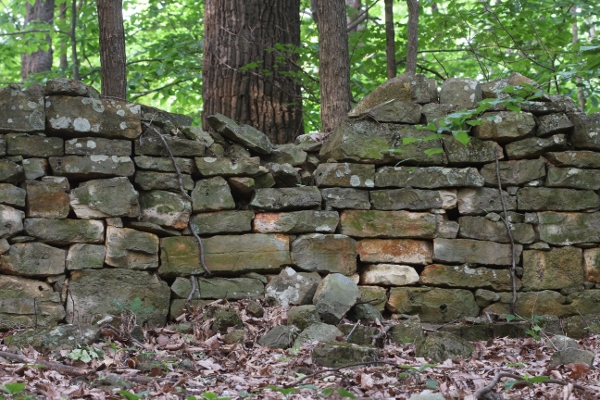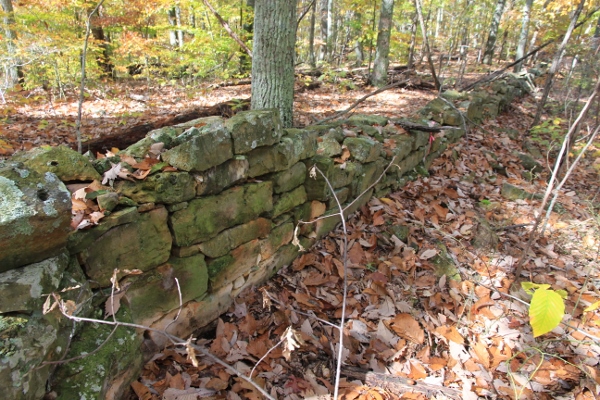
Featured ANIMALS
Box Turtles
Timber Rattlesnakes
Coyotes
Streamside Salamander
Featured PLANTS
Spring Ephemerals
Old Growth
Forest Composition
Essay on woods
Honeysuckle
LANDSCAPE
Historic Wall
Geology
Cave
Waterfall
Conservation
Ecological Corridor
Development Planning

 Walking through the proposed "Bob Brown Park," I come upon the old Belle Meade Plantation wall and stop to consider it. Winding its way through 100+ year old forest, the wall has its own beauty. Unlike other walls around town, this one is cut of Chert mined from these hilltops. Chert is why our hills are capped with distinctive communities dominated by by Chestnut Oak, Sourwood, Azalea, Deerberry, and other low-pH, low-moisture loving plants. Chert breaks with sharp edges, a feature which also qualifies it as a good material for arrowheads and other stone tools. This smooth yellow stone hints at life in the shallow sea that stood here 350 million years ago.
Walking through the proposed "Bob Brown Park," I come upon the old Belle Meade Plantation wall and stop to consider it. Winding its way through 100+ year old forest, the wall has its own beauty. Unlike other walls around town, this one is cut of Chert mined from these hilltops. Chert is why our hills are capped with distinctive communities dominated by by Chestnut Oak, Sourwood, Azalea, Deerberry, and other low-pH, low-moisture loving plants. Chert breaks with sharp edges, a feature which also qualifies it as a good material for arrowheads and other stone tools. This smooth yellow stone hints at life in the shallow sea that stood here 350 million years ago.
 Many folks who support conservation of the West Meade landscape are keen to see this wall preserved. I admit, however, that over the years I have taken only a passing interest in this part of our landscape. As a naturalist, my focus on the plants, animals and geology have trumped curiosity about the human history. Perhaps a part of me also didn't want to confront the fact that the wall in my back yard was built by slaves and stands as a legacy of a social order that was best dismantled. Yet, as racial discord has seized the attention of our nation in the last year, doesn't this wall stand as an important reminder of the roots of inequality? It seems too easy to forget that the reason black Americans are disproportionately represented among the poor and imprisoned traces back to the time that 25% of Tennessee's population was forced to build this and so many other walls.
Many folks who support conservation of the West Meade landscape are keen to see this wall preserved. I admit, however, that over the years I have taken only a passing interest in this part of our landscape. As a naturalist, my focus on the plants, animals and geology have trumped curiosity about the human history. Perhaps a part of me also didn't want to confront the fact that the wall in my back yard was built by slaves and stands as a legacy of a social order that was best dismantled. Yet, as racial discord has seized the attention of our nation in the last year, doesn't this wall stand as an important reminder of the roots of inequality? It seems too easy to forget that the reason black Americans are disproportionately represented among the poor and imprisoned traces back to the time that 25% of Tennessee's population was forced to build this and so many other walls.
-Noah |